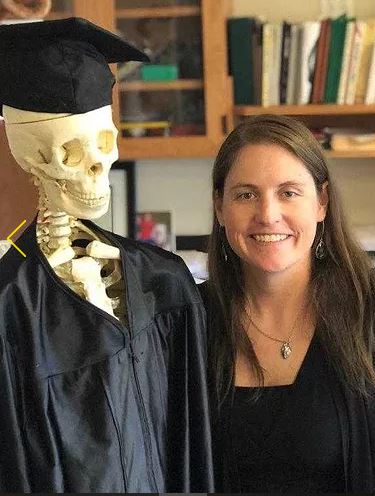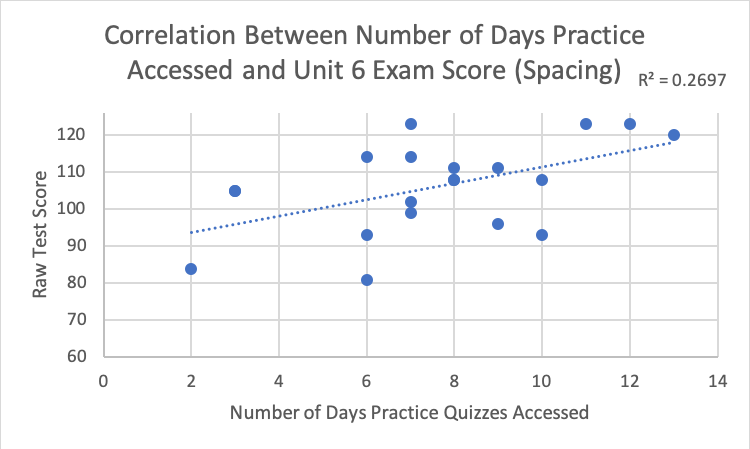GUEST POST: When Implementing Retrieval and Spaced Practice in the Science Classroom, Change Won’t Happen Overnight
By Alison Stone
Alison Stone teaches Human Anatomy and Physiology and AP Biology at Central Bucks High School – West in Doylestown, PA. She is a National Board Certified Teacher and the 2015 recipient of the Outstanding Educator Award from Stephenson University. Alison has a passion for using evidence-based practice to improve student outcomes in her classroom. She can be found on Twitter at @alisonstoneCBSD.
I teach Biology and Human Anatomy and Physiology at a High School in southeastern Pennsylvania. I regularly use practice quizzes as a way for students to prepare for my exams (particularly in Anatomy). I collected data for years on student test performance and quiz behavior; students that take my practice quizzes (which are assigned for homework) consistently score 10% points higher on unit assessments than those students who do not. I knew I was really onto something with low stakes, pre-test quizzing. Showing these data to my students is powerful but I was unable to clearly to explain to them WHY practice quizzes improved their learning. Last summer when I discovered the Learning Scientists, this problem was resolved. I was finally able to start using the correct vocabulary for the strategies I am using, add additional strategies to my instruction, and learn the research behind these methods. All of this has been powerful for my instruction.
Integrating Retrieval and Spacing into AP Biology
At the end of last year, when I learned I would be teaching a section of Advanced Placement Biology I knew I wanted to apply the same strategies because of my success using retrieval with my Anatomy classes. In fact, because of the greater quantity of content and rigor of the course it would be essential for me to teach the learning strategies outlined by the Learning Scientists to improve student outcomes. Along with a colleague who was also teaching the course for the first time, I spent most of my summer working on converting the very thorough review packets developed by our district’s veteran AP Biology teachers into online quizzes (using the website: www.quia.com). Students would use these quizzes as practice for test preparation. Nearly 2,000 quiz questions later, I felt that my retrieval practice was ready for the upcoming school year.
Initial Results
Initially, my methods did not yield the student outcomes that I was expecting; about six weeks into my AP Biology course, I had to go back to the drawing board. Initially I asked my students to take the practice quizzes on multiple days (setting up a spacing schedule). For example, they needed to access the quiz on at least four different days before the unit exam. I did not assign the quiz on specific days; I let them decide when to complete the quiz. Additionally, I was not holding them accountable to specific proficiency standards because I assumed that several days of spaced practice would yield the desired proficiency. Because these quizzes were meant to encourage retrieval, I told students not to use notes when completing the practice quizzes. I then looked to see if there was a relationship between the number of days the quiz was accessed and test scores. However, there was no correlation, and this was not the outcome I was anticipating.
Image by Alison Stone
The quiz design for this assignment was clearly not working for every student. I tried graphing their average high score on the six practice quizzes they took to prepare for the 2nd unit exam:
Image by Alison Stone
Again, I was dissatisfied in the results. I knew practice quizzes had been effective for other courses I taught, yet the correlation was not evident. I shared these data with Megan Sumeracki to see if she could give me any insight. I also had a discussion with my students, where I shared the above graphs and asked them if they had feedback for me.
Evaluating and Making Changes
Megan thought the questions on the practice quizzes might be too challenging. So, she recommended I allow students to use their notes until they received a proficient score and then wean themselves from the notes. She also suggested that I assign due dates for proficiency to provide more structure to their study schedule. Lastly, she suggested I introduce more (scaffold-free) retrieval into the classroom.
Interestingly, my students echoed Megan’s suggestion that the questions may be too hard. Many of them said that they were just guessing on the quizzes. They were taking the retrieval practice to heart and not using their notes, but as a result they were frustrated. I think many of them were ready to give up on retrieval practice, which further motivated me to make some changes to achieve better outcomes and greater buy in.
I had a conversation with my class about how they might need to scaffold at the beginning of the unit but as they approach the test date, they should attempt the quizzes without the notes in order to give them a truer idea of their knowledge. I added a survey question to the end of my practice quizzes: “I used my notes - scaffolding” or “I completed this without notes – retrieval” so I could keep track of how they were using the quizzes and so they could also keep track of what they were doing. Giving them the option of scaffolding helped with the frustration they were experiencing. Additionally, I found that my still-struggling students were typically the ones who were still clicking the “I used my notes” option the night before the test. These students were unable to fully utilize the retrieval for metacognitive purposes and were therefore not able to reap as many benefits of the quizzes.
To improve spacing I tweaked my practice quizzes to utilize older questions when students were taking practice quizzes on more recent material. I intend to further apply this concept in the future by integrating even older questions into in class retrieval and the practice quizzes.
In addition, I now make it a point to do daily retrieval in class, and have integrated different methods of retrieval practice (e.g., practice quizzes, brain dumps, list-amass-pass, sketch notes, etc.). Adding retrieval to the classroom helps students who are not doing as much practice at home. This practice also demonstrates just how important I think retrieval practice is to my students.
New Results
Over the last several months, I have observed a shift in student attitudes toward retrieval and spacing. They became more receptive to these strategies. On our last unit test student participation in practice quizzes was nearly 100%, and many are taking them until they feel comfortable with the content (rather than simply taking the quiz to achieve proficiency (80%)). I have seen improvement in their grades and their confidence. Recently, several excited students came into my class to share that they were learning about retrieval and spacing in their AP Psychology class. One of my toughest students (not an eager adaptor) told me he explained how brain dumps worked to the rest of his AP Psychology class. Here are some data from a recent exam:
Image by Alison Stone
Image by Alison Stone
Clearly, I still have work to do. I can, however, see the impact that these strategies are having on my students and I hope that they also see the impact. Retrieval and spacing are skills that are transferrable to any learning environment. It is my hope that my students leave my classroom with new found confidence in their ability to learn complex, rigorous content.








